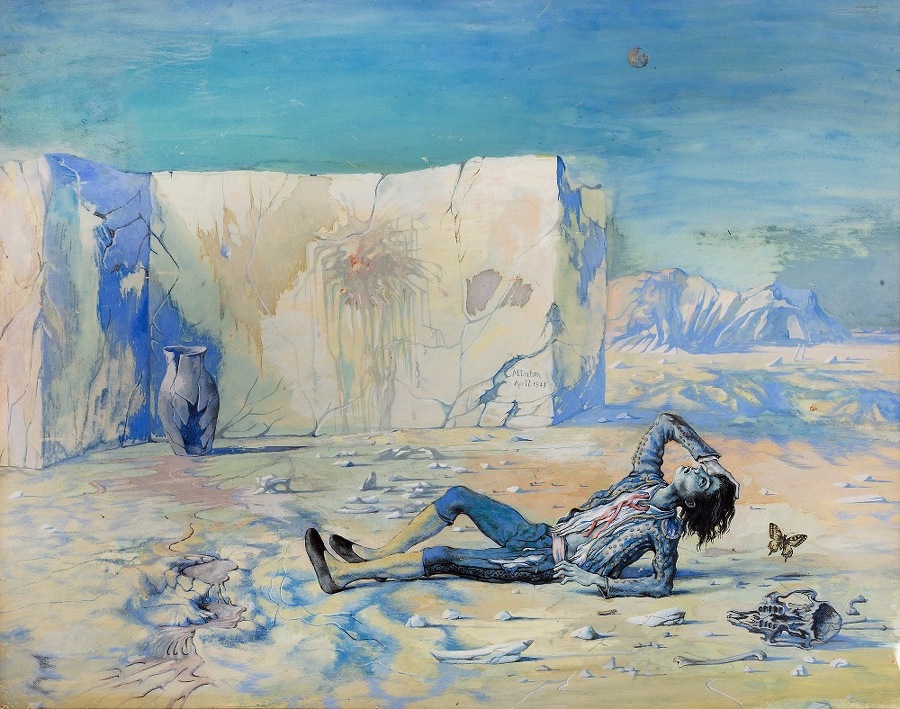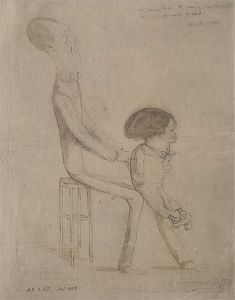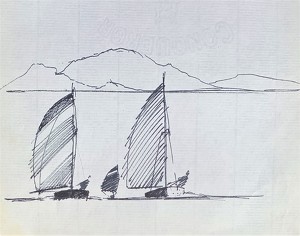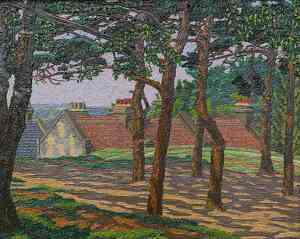

1917-1957
The Bullfighter
Ref: 1581
Signed and dated on the corner of the wall: Minton/April 1941
Pen, ink, watercolour and gouache, 48 by 61 cm
Provenance: Redfern Gallery, London, March 1945 where acquired by Sigmund Politzer Esq
Exhibited: John Minton – A Centenary, Pallant House Gallery, Chichester, July-October 2017, cat.fig 9, illustrated in colour, p.17
Although dated 1941, the painting is a throwback to interests that John Minton had developed in the late 1930s, first at St John’s Wood School of Art and then in Paris. It draws on his interest in ballet, in the French Neo-Romantics and on his fascination with the ruined town of Les Baux, in Provence. While at art school Minton had met Michael Ayrton and also Ayrton’s friend Michael Middleton. All three friends read James Thrall Soby’s After Picasso (1935) which, according to Minton ‘became our Bible’. Its importance lay in the fact that it had identified a reaction against cubist inspired abstraction and, in its place, a desire to replace emotional restraint with poetic intensity. Soby directed Minton’s intention to the Surrealists and the French Neo-Romantics, in particular the Paris based Russians, Eugene Berman and Pavel Tcheltichew, and the Frenchman Christian Berard, who looked to Picasso’s Blue and Rose period for inspiration. ‘The Neo-Romantic painters’, Soby pronounced, ‘are filling their canvases with unashamed poignancy’. Soby’s book sent Minton in December 1938 to Paris, where Ayrton joined him in the spring of 1939.
It was in Paris that Minton first began to experiment with the striking perspectives and stagey vistas employed by both the Neo-Romantics and the Surrealists. Likewise, the Neo-Romantics’ heavy use of blue encouraged his leaning at this time towards monochromatic effects. He and Ayrton, conscious that they were following in the footsteps of Berard, went to Provence and twice visited Les Baux. ‘Les Baux is an extraordinary place,’ Minton wrote to his friend Edie Lamont, ‘once the capital of Provence, there are now forty-eight inhabitants, and the rest is fantastic ruins with enormous rocks strewn about in curious positions. The whole atmosphere is charged with romantic desolation. I did a lot of paintings and crowds of little drawings.
The Bullfighter is one of several images from the period that draw on Minton’s memory of Les Baux and which made use of the shards of rock and sharply etched shadows. He frequently introduced into these works solitary figures, in a wistful manner reminiscent of Berard’s waifs and strays. But The Bullfighter may contain a more specific literary or balletic source for the details of the broken pot, the dead figure, the butterfly and the suggestion, on the rocky wall behind, of a recent shooting, create a melancholy and fateful mood. By August 1939, when he began a self-portrait with the Seine in the background, he was beginning to be critical of his youthful enthusiasms and described the painting as ‘all very blue, with lots of bogus Berman quality’.
Minton did not exhibit The Bullfighter until March 1945 when it was hung at The Redfern. He had regularly shown work in group exhibitions at this gallery since 1943. It had, and still has, a lower ground floor. Minton’s friends Robert Colquhoun and Robert MacBryde, teasingly referred to it as ‘Min’s bargain basement’, perhaps because they were a little envious of his sales.
The present text is closely based on material from Frances Spalding’s biography of John Minton, Dance till the Stars Come Down, published by Hodder & Stoughton in 1991.
 SOLD
SOLD




